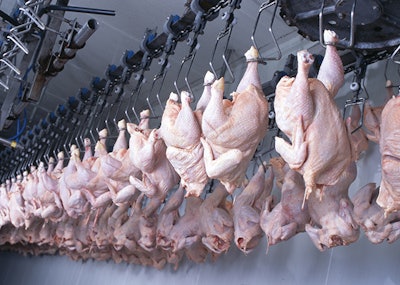
Poultry processing plants are challenging environments to work in, even for robotic and other automated technologies.
Robots can be a great solution to help augment human labor when tasks fall under the one of the four Ds: dangerous, dirty, demeaning or dull, Nathan Hunt, Robotics and Vision Solution Consultant, CED Industrial Solutions, said during The Poultry Federation Poultry Symposium for Production & Processing.
During the session, Hunt explained how modern robotics are designed for improved effectiveness in challenging poultry processing environments.
Bacteria
Poultry processing plants are a breeding ground for bacteria, which can lead to cross-contamination and product recalls. In the past, robots were not necessarily designed for easy sanitation.
Now, hygienic design has become more of a focus. For example, surfaces are designed to be curved, rather than flat, which can protect against sitting water.
“Sitting water is a place where bacteria can grow, so all the lines are curved,” he said. “In addition, none of those curves ever come up to an angle. It’s all curved so that water runs off.”
Washdown
The washdown process can be corrosive, which can gradually wear down equipment and create permeable surfaces that are difficult to clean.
Improvements in robotic design protect against corrosion, making them easier to keep clean of bacteria.
Variety and variability
In a typical manufacturing facility, robots interact with boxes or other items that are consistently the same shape and size. That’s not true in poultry processing, where even the same cut can vary.
“No chicken looks the same. No turkey looks the same. And none of the breast meat looks the same. To be able to handle those different pieces, it can be very difficult for an automation system,” Hunt explained.
Space/people
“With COVID, fitting people into a space has become more difficult. Now, imagine trying to also fit a gigantic robotic cell in that space. Something we have to consider in the automation space is safety working next to people,” Hunt said.
In some cases, robots can supplement human labor, allowing other employees to increase the space between them. Other designs hang from the ceiling and free up floor space. Regardless, worker safety is crucial.
Like what you just read? Sign up now for free to receive the Poultry Future Newsletter


















